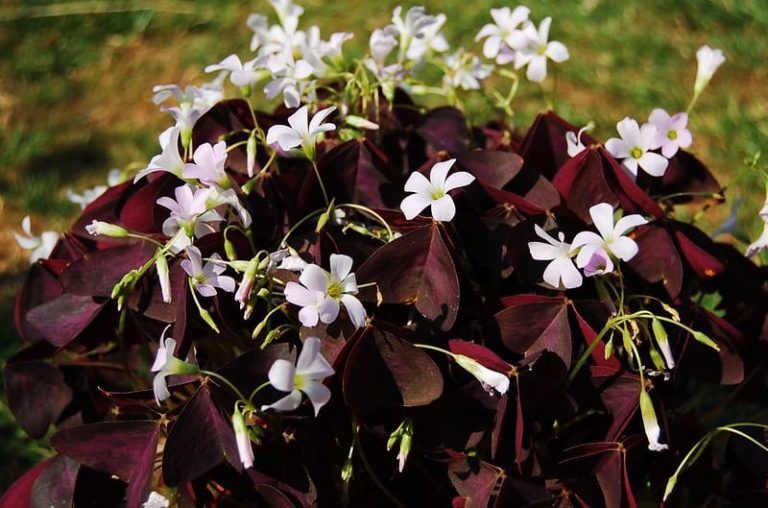Title:

Source youhadmeatgardening.com
Welcome to our comprehensive guide on caring for oxalis indoors! If you’re a plant enthusiast looking to add a touch of elegance and vibrancy to your indoor spaces, oxalis is an excellent choice. Also known as the shamrock plant, oxalis features delicate leaves and charming flowers that can brighten up any room. In this article, we will explore the essential aspects of oxalis care indoors, including watering, lighting, temperature, and repotting. By the end, you’ll be equipped with all the knowledge you need to provide the best care for your oxalis and ensure its flourishing growth.
1. Understanding the Needs of Oxalis
Proper Lighting for Oxalis
Oxalis thrives in bright, indirect light. Placing it near a window that receives gentle morning or afternoon sun is ideal. Direct sunlight can scorch the leaves, so it’s best to avoid exposing your oxalis to intense rays. If your indoor space lacks sufficient natural light, consider using artificial grow lights that emit a balanced spectrum of light.
Remember to rotate your oxalis pot every few days to ensure even growth, as the plant tends to lean towards the light source. This will help maintain a well-rounded and attractive shape.
Optimal Temperature and Humidity
The recommended temperature range for oxalis is between 60°F (15°C) and 75°F (24°C). It’s essential to protect your plant from extreme cold or heat, as it can negatively impact its growth.
Additionally, oxalis prefers moderate humidity levels. If you live in a dry climate or during the winter months when indoor heating can cause dryness, misting the plant occasionally or using a humidifier can help maintain adequate moisture levels.
2. Watering Tips for Oxalis
Watering Frequency and Method
The key to watering oxalis is finding the right balance. Overwatering can cause root rot, while underwatering can lead to dehydration. Aim to keep the soil slightly moist but not overly wet or waterlogged.
Regularly check the moisture level of the soil by sticking your finger about an inch deep into the pot. If it feels dry at this depth, it’s time to water your plant. Water thoroughly, allowing the excess water to drain out from the pot’s drainage holes. Empty any water accumulated in the saucer to prevent the roots from sitting in standing water.
3. Repotting and Fertilizing
When to Repot Your Oxalis
Repotting is essential for the healthy growth of oxalis. As the plant matures and its rhizomes multiply, it may outgrow its current container. Look for signs like roots poking out of the drainage holes or a crowded root mass to determine if it’s time to repot.
Spring is the best time to repot oxalis, as it’s during the growing season. Choose a pot that is one size larger than the current one, and use a well-draining potting mix to ensure optimal root health.
Table: Nutrient Preferences of Oxalis Varieties
| Variety | Nitrogen (N) | Phosphorus (P) | Potassium (K) |
|---|---|---|---|
| Oxalis triangularis | High | Low | Medium |
| Oxalis deppei | Low | Medium | High |
Frequently Asked Questions about Oxalis Care Indoors
Q: How often should I fertilize my oxalis?
A: It’s recommended to fertilize your oxalis once a month during the growing season (spring and summer) using a balanced liquid fertilizer diluted to half the recommended strength. Reduce or stop fertilizing during the winter months when the plant is in a dormant phase.
Q: What should I do if my oxalis leaves start turning yellow?
A: Yellowing leaves on oxalis can be indicative of overwatering or underwatering. Check the moisture level of the soil and adjust your watering routine accordingly. If the roots are healthy and the watering is consistent, the yellowing could be a sign of inadequate nutrients. Consider fertilizing your plant to replenish any nutrient deficiencies.
Conclusion
Oxalis care indoors can be a rewarding and enjoyable experience, allowing you to witness the plant’s vibrant colors and delicate foliage up close. Remember to provide adequate lighting, maintain suitable temperature and humidity levels, water with care, and repot when necessary. By applying the tips and techniques discussed in this article, you’ll be giving your oxalis the best chance to thrive and become a stunning addition to your indoor garden.